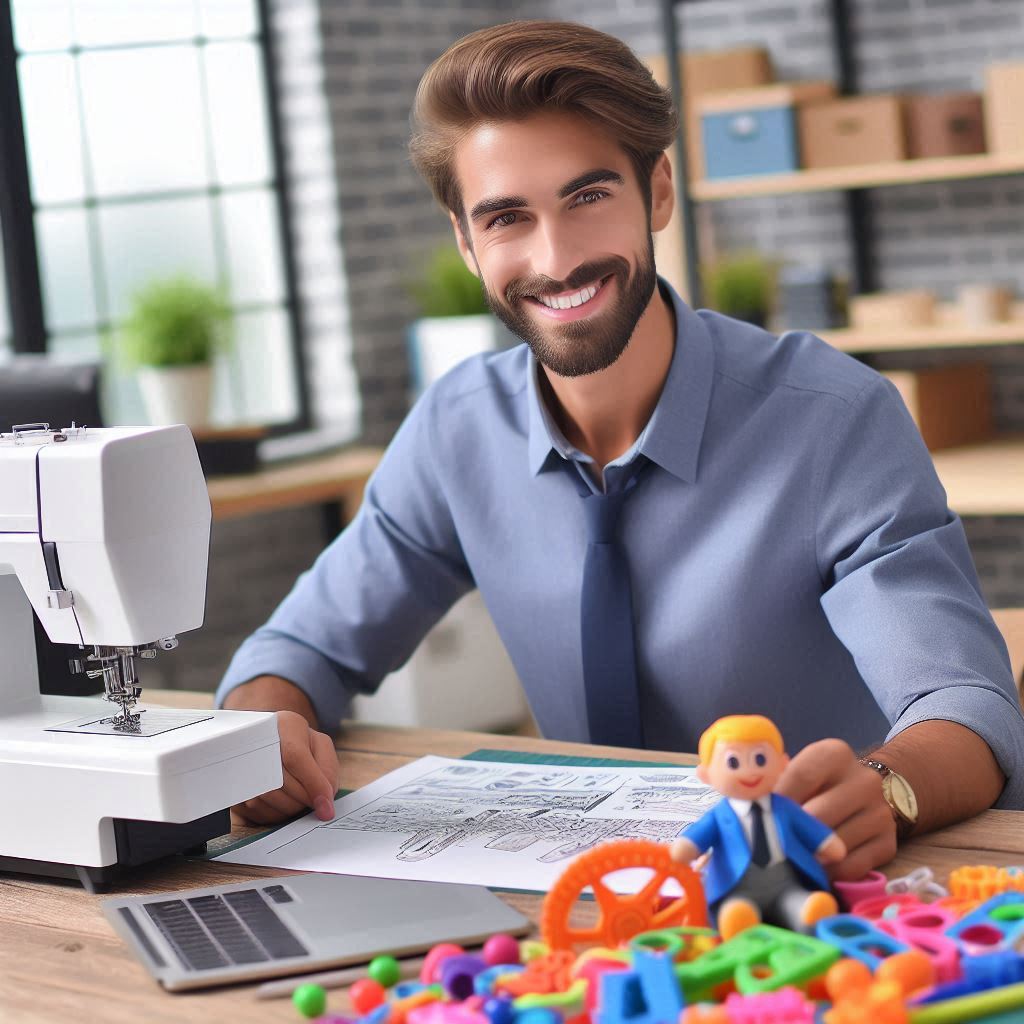Introduction
Toy designers are creative professionals who conceptualize and design toys for children.
Importance of having the right tools for toy design
Having the right tools is crucial for toy designers as it enables them to bring their ideas to life effectively.
Sketching materials such as pens, pencils, markers, and sketchbooks are essential for exploring and communicating ideas visually.
Computer software like Adobe Illustrator and Photoshop allows designers to create digital drawings and renderings.
3D modeling software like Rhino and SolidWorks helps toy designers visualize their designs in three dimensions.
Prototyping tools such as clay, foam, and 3D printers are vital for creating physical models of toy designs.
Measuring tools like rulers, calipers, and scales are necessary for ensuring accurate dimensions and proportions.
Cutting tools like X-Acto knives and scissors are essential for precise cutting and shaping of materials.
Adhesives such as glue, tape, and epoxy are important for assembling and joining different parts of a toy together.
Testing equipment like drop testers and impact testers are used to assess the safety and durability of toy designs.
Packaging tools like prototyping machines and graphics software help designers create attractive packaging for their toys.
Collaboration tools like project management software and video conferencing platforms facilitate communication and teamwork among toy design teams.
Computer Software
When it comes to toy design, having the right tools is crucial to bringing your ideas to life.
From concept development to final production, designers rely on a variety of software to streamline their workflow and create stunning designs.
Adobe Illustrator
Adobe Illustrator is a staple tool for toy designers, offering a wide range of features for creating digital designs.
From sketching out initial concepts to creating detailed illustrations, Illustrator is versatile and easy to use.
Its vector-based approach allows for scalability and precision, making it ideal for designing both 2D and 3D toys.
With a vast selection of drawing tools, color options, and effects, Illustrator empowers designers to unleash their creativity and bring their ideas to life.
Whether you’re designing characters, packaging, or promotional materials, Illustrator is a must-have tool in any designer’s arsenal.
CAD Software
For toy designers looking to create intricate 3D models, CAD (Computer-Aided Design) software is essential.
Transform Your Career Today
Unlock a personalized career strategy that drives real results. Get tailored advice and a roadmap designed just for you.
Start NowThese powerful tools allow designers to visualize their designs in three dimensions, turning ideas into tangible objects.
Using CAD software, designers can manipulate shapes, dimensions, and textures to create realistic prototypes of their toys.
Whether you’re working on a plush toy, action figure, or vehicle, CAD software provides the precision and detail needed to bring your designs to life.
Photoshop
In the world of toy design, presentation is key.
Photoshop is a powerful tool for editing images, creating mockups, and enhancing the visual appeal of your designs.
Whether you’re creating product renders, packaging designs, or promotional materials, Photoshop allows you to refine every detail and create stunning visual assets.
With features like layering, masking, and color correction, Photoshop gives designers the flexibility to experiment and iterate on their designs.
Whether you’re exploring different color schemes, adding textures, or creating special effects, Photoshop is an indispensable tool for bringing your toy designs to life.
Overall, computer software plays a vital role in the toy design process, empowering designers to explore their creativity, refine their concepts, and bring their ideas to life.
By leveraging the power of tools like Adobe Illustrator, CAD software, and Photoshop, designers can create innovative and captivating toys that inspire imagination and delight consumers of all ages.
Read: From Concept to Creation: Toy Design Process
Clay and Sculpting Tools
When it comes to toy design, one of the most essential tools for designers is clay and sculpting tools.
These tools play a vital role in the prototyping and shaping process of creating new toys.
Let’s take a closer look at why these tools are a must-have for toy designers.
Clay for creating prototypes
Clay is a versatile material that allows designers to quickly and easily create prototypes of their toy designs.
It provides a tactile experience that digital design tools cannot replicate.
By shaping and molding clay, designers can physically see and feel their designs, making it easier to refine and iterate on their ideas.
Sculpting tools for shaping and detailing
Sculpting tools are essential for toy designers to sculpt and shape their clay prototypes with precision.
These tools come in various shapes and sizes, allowing designers to create intricate details and textures on their toys.
Showcase Your Business Today
Reach thousands of readers actively exploring professional services. Publish your business profile and grow your audience now.
Publish NowWhether it’s adding fine lines or carving out shapes, sculpting tools are indispensable for bringing a toy design to life.
Oven for baking and hardening clay
Once the clay prototype is sculpted and shaped, it needs to be baked in an oven to harden and set.
This process ensures that the final toy design is durable and long-lasting.
By using an oven, toy designers can transform their soft clay prototypes into sturdy and solid models ready for further testing and production.
In fact, clay and sculpting tools are must-have tools for toy designers.
These tools enable designers to create tangible prototypes, sculpt intricate details, and harden their designs for further development.
By incorporating these tools into their design process, toy designers can bring their creative visions to life and create innovative and appealing toys for children around the world.
Read: How to Break into the Toy Design Industry
Cutting Tools
Toy designers rely on a variety of cutting tools to bring their creative ideas to life.
Precision and efficiency are key, making the right tools essential for every design project.
X-Acto knives for precision cutting
X-Acto knives offer designers unmatched precision.
These sharp blades allow for detailed cuts, making them ideal for intricate designs.
Whether you’re working with paper, foam, or other materials, an X-Acto knife ensures you achieve clean and accurate cuts.
Its versatility makes it a go-to tool for toy designers aiming for detail-oriented work.
Rotary cutters for cutting fabric
Rotary cutters are perfect for cutting fabric smoothly and quickly.
These tools provide clean, straight lines without snagging the material.
When designing plush toys or other fabric-based creations, rotary cutters save time while maintaining accuracy.
With a rolling blade, they minimize the effort needed to slice through multiple layers, making them a must-have for fabric projects.
Scissors for general cutting tasks
Scissors remain a staple in any toy designer‘s toolkit.
They‘re versatile and handle a wide range of cutting tasks.
From trimming threads to cutting paper and cardboard, scissors provide an easy, reliable solution.
Their simplicity doesn‘t compromise their importance, as every toy designer depends on them for various day-to-day cutting tasks.
In general, X-Acto knives, rotary cutters, and scissors each serve vital roles in toy design.
Each tool contributes to achieving the precision and creativity necessary for high-quality toys.
Investing in these cutting tools helps designers produce polished and professional products efficiently.
Read: Toy Design Trends: What‘s Hot in 2024?

Glue and Adhesives
When it comes to designing toys, having the right tools is essential to bring your creations to life.
One of the must-have tools for toy designers is glue and adhesives.
These tools help in joining different materials together, creating strong bonds that are crucial for a durable and functional toy.
Cyanoacrylate Glue
Cyanoacrylate glue, commonly known as super glue, is a versatile adhesive that is ideal for quick bonding of various materials such as plastic, metal, and rubber.
It dries quickly, allowing you to work efficiently without waiting for long drying times.
Wood Glue
For toy designers working with wooden components, wood glue is a must-have adhesive.
Wood glue creates strong and durable bonds, making it suitable for assembling wooden toys that require stability and durability.
It is important to choose a high-quality wood glue to ensure the longevity of your creations.
Hot Glue Gun
A hot glue gun is a handy tool for toy designers, especially when it comes to quick fixes and attaching components.
The hot glue gun dispenses molten adhesive that solidifies quickly, making it ideal for temporary fixes or for securing small parts in place.
It is also useful for creating prototypes or making adjustments on the go.
In short, glue and adhesives are essential tools for toy designers, providing them with the ability to create durable and functional toys.
Whether you need quick bonding, strong bonds, or temporary fixes, having the right type of glue and adhesive can make a significant difference in the quality of your toy designs.
Read: Toy Design Degrees: Best Colleges and Programs
Showcase Your Business Today
Reach thousands of readers actively exploring professional services. Publish your business profile and grow your audience now.
Publish NowPaint and Coloring Supplies
Effective toy design relies heavily on the right paint and coloring supplies.
Each tool plays a critical role in bringing ideas to life.
Here are three essential supplies every toy designer should have.
Acrylic paint for coloring prototypes
Acrylic paint serves as a versatile option for coloring prototypes.
It dries quickly and provides vibrant colors.
Designers appreciate its ability to adhere well to various surfaces.
Acrylic paint is also non-toxic, making it safe for children‘s toys.
This feature ensures compliance with safety regulations.
Designers can easily mix colors to achieve desired shades.
The water-based nature of acrylic paint allows for easy cleanup.
Use acrylic paint to enhance the look of your prototypes effectively.
Markers for sketching and detailing
Markers are vital for sketching initial designs and adding details.
They offer precision and control for intricate work.
Many types of markers exist, including permanent, washable, and specialty options.
Designers can use fine-tip markers for detailed drawings.
Broad-tip markers work well for bold lines and larger areas.
Markers provide quick solutions for adding color and texture.
They are convenient for on-the-go sketching and brainstorming.
Using markers, designers can convey their ideas clearly and creatively.
Airbrush for smooth and even coloring
An airbrush is an excellent tool for achieving smooth, even coloring on toy surfaces.
It allows for fine control over paint application.
This technique produces professional-looking results with minimal brush strokes.
Airbrushing is particularly effective for gradient effects and shading.
It can also cover larger areas quickly and evenly.
Designers often use airbrushes for intricate patterns and designs.
While it requires practice, mastering an airbrush can elevate toy designs significantly.
In review, paint and coloring supplies are essential tools for toy designers.
Acrylic paints, markers, and airbrushes each contribute uniquely to the creative process.
Incorporating these tools enhances the quality and visual appeal of toy prototypes.
Prototyping Materials
When it comes to toy design, prototyping is a crucial step in the process.
Prototypes allow designers to test concepts, evaluate functionality, and make necessary revisions before final production.
Cardboard for creating mockups
Cardboard is an essential tool for toy designers when creating mockups of their designs.
It is lightweight, easy to cut, fold, and manipulate, making it ideal for quickly visualizing initial concepts.
Foam board for building structures
Foam board is another valuable material for toy designers, especially when building structures or larger-scale prototypes.
Its durability and ease of use make it a popular choice for creating three-dimensional models.
3D printer for printing prototypes
In recent years, 3D printing technology has revolutionized the prototyping process for toy designers.
It allows for precise and detailed prototypes to be created quickly, saving time and resources in the development phase.
Overall, having access to a variety of prototyping materials such as cardboard, foam board, and a 3D printer is essential for toy designers to bring their ideas to life effectively and efficiently.
These tools enable them to iterate on their designs, test functionality, and ultimately create successful and marketable toys.
Delve into the Subject: Creative Director Success Stories: Inspiration
Showcase Your Business Today
Reach thousands of readers actively exploring professional services. Publish your business profile and grow your audience now.
Publish NowMeasurement Tools
As a toy designer, having the right tools is essential for creating innovative and high-quality designs.
One crucial aspect of toy design is ensuring accurate measurements to ensure that all components fit together seamlessly.
Here are some must-have measurement tools for toy designers to have in their toolbox:
Ruler
A ruler is a basic yet essential tool for toy designers.
It allows for precise measurements and ensures that all components are the correct size.
Whether you are working on a small figurine or a larger playset, a ruler is indispensable in the design process.
Calipers
Calipers are another essential tool for toy designers, especially when it comes to measuring thickness and dimensions.
They provide accurate measurements that are crucial for ensuring that parts fit together correctly.
Whether you are working with plastic, wood, or metal components, calipers are a versatile tool that can handle various materials.
Compass
In toy design, creating precise circles and arcs is often necessary for creating certain components or shapes.
A compass is a handy tool for drawing perfect circles and arcs with ease.
Whether you are sketching out a design or creating patterns for 3D printing, a compass can help you achieve the desired shapes accurately.
Having these measurement tools in your arsenal as a toy designer will help you streamline your design process and ensure the quality and accuracy of your creations.
By investing in high-quality measurement tools, you can take your toy designs to the next level and bring your creative vision to life with precision and detail.
Storage and Organization
Designing toys requires a wide array of tools and materials to bring your ideas to life.
However, having the right tools is only half the battle.
It’s crucial to have a system in place for storing and organizing these tools.
This not only saves time but also helps keep your workspace clutter-free and efficient.
Storage bins for keeping tools and materials organized
Storage bins are a must-have for any toy designer.
They come in various sizes and can be used to store everything from paints and brushes to small parts and components.
By categorizing your tools and materials into different bins, you can easily locate what you need without rummaging through a messy workspace.
Tool caddy for easy access to frequently used tools
A tool caddy is another essential storage solution for toy designers.
This portable organizer allows you to keep your most frequently used tools within arm’s reach.
Whether you’re working at your desk or moving around the workshop, having a tool caddy ensures that you always have the right tool for the job.
Label maker for labeling and identifying tools
One often overlooked but highly useful tool for toy designers is a label maker.
By labeling and identifying your tools, you can quickly find what you need without wasting time searching through drawers or bins.
This simple tool can make a world of difference in your productivity and efficiency.
In a nutshell, investing in proper storage and organization tools is essential for toy designers.
By using storage bins, a tool caddy, and a label maker, you can keep your workspace tidy and efficient.
This not only saves time but also helps you stay focused on the task at hand.
So, make sure to prioritize storage and organization in your toy design toolkit.
Conclusion
Having the right tools is crucial for toy designers.
Quality tools enhance creativity and improve the design process.
Designers can transform ideas into tangible products with precision and ease.
Investing in high-quality tools leads to better results and more satisfying projects.
Tools such as 3D printers, CAD software, and prototyping materials are essential.
These tools allow designers to visualize concepts and test functionality.
Furthermore, reliable hand tools ensure accuracy and safety during the design process.
Each tool plays a unique role in shaping innovative and engaging toys.
Moreover, quality tools can save time and reduce frustration.
Showcase Your Business Today
Reach thousands of readers actively exploring professional services. Publish your business profile and grow your audience now.
Publish NowDesigners spend less time fixing mistakes when they use dependable equipment.
This efficiency allows for more time dedicated to creative exploration and refinement.
Encouraging investment in high-quality tools promotes professionalism in the toy design industry.
Designers who invest in their tools often see a return on investment through improved designs and customer satisfaction.
The right tools empower toy designers to unleash their creativity.
Quality equipment enables the realization of imaginative concepts into beloved toys.
By prioritizing tool selection, designers can elevate their work and contribute to the vibrant world of toy design.
[E-Books for Sale]
The Big Book of 500 High-Paying Jobs in America: Unlock Your Earning Potential
$19.99 • 500 High-Paying Jobs • 330 pages
Explore 500 high-paying jobs in America and learn how to boost your career, earn more, and achieve success!
See All 500 High-Paying Jobs of this E-Book
1001 Professions Without a Degree: High-Paying American Jobs You Can Start Now
$19.99 • 1001 Professions Without a Degree • 174 pages
Discover 1001 high-paying jobs without a degree! Unlock career tips, skills, and success strategies for just $19.99!




